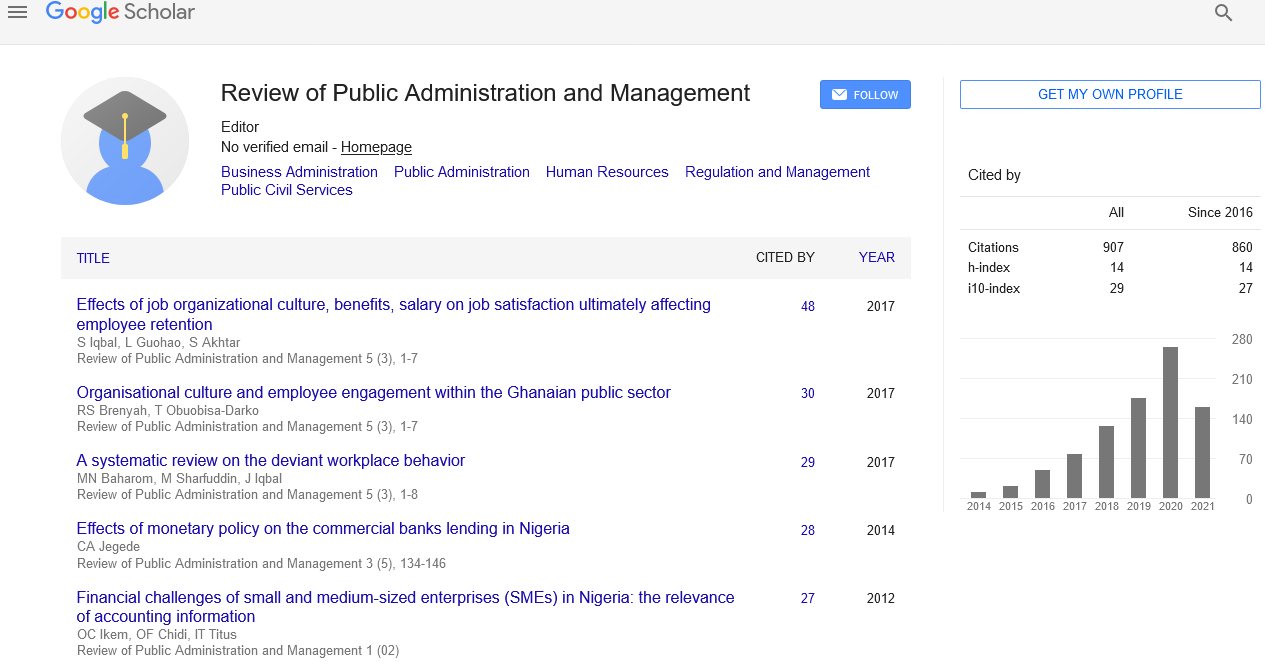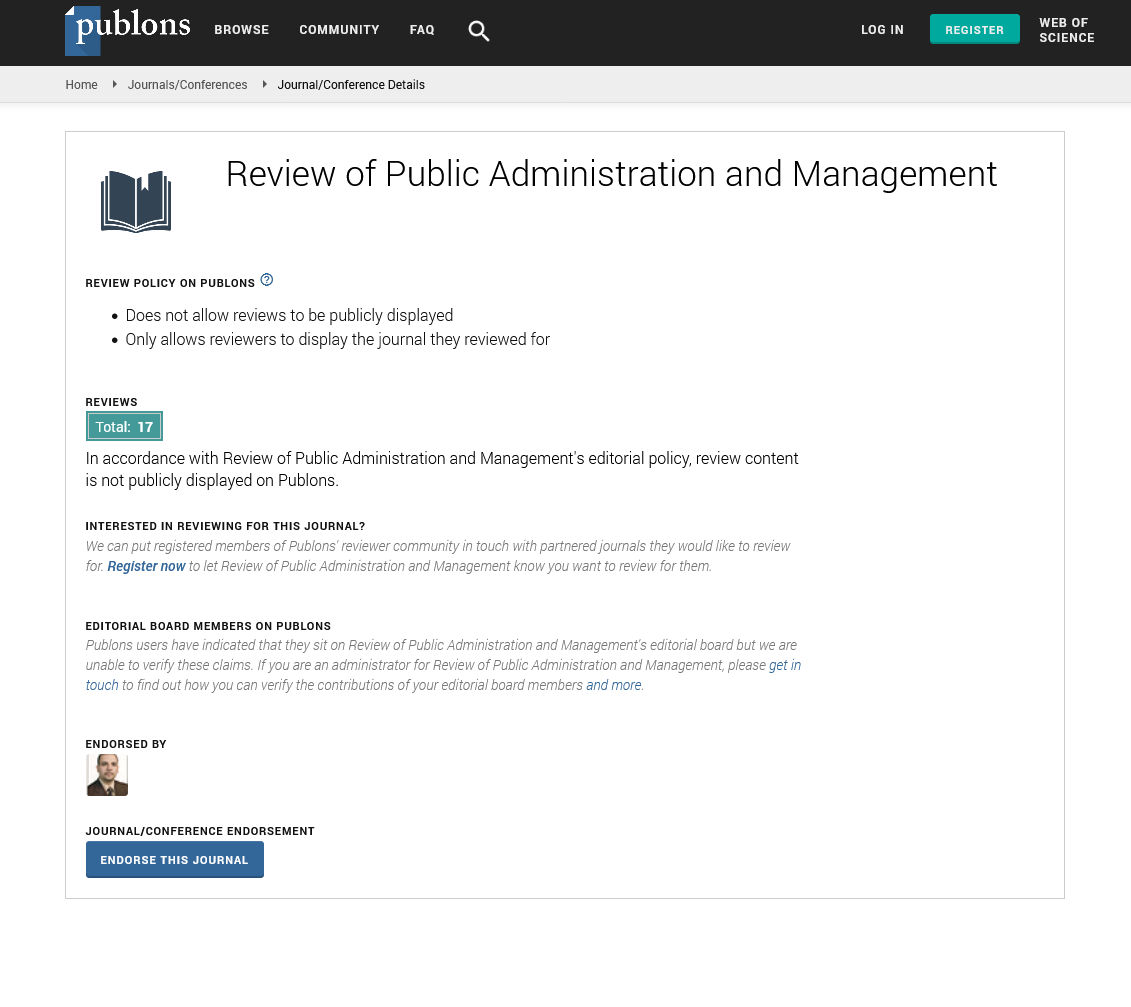Indexed In
- CiteFactor
- RefSeek
- Directory of Research Journal Indexing (DRJI)
- Hamdard University
- EBSCO A-Z
- Scholarsteer
- Publons
- Euro Pub
- Google Scholar
Useful Links
Share This Page
Journal Flyer

Open Access Journals
- Agri and Aquaculture
- Biochemistry
- Bioinformatics & Systems Biology
- Business & Management
- Chemistry
- Clinical Sciences
- Engineering
- Food & Nutrition
- General Science
- Genetics & Molecular Biology
- Immunology & Microbiology
- Medical Sciences
- Neuroscience & Psychology
- Nursing & Health Care
- Pharmaceutical Sciences
Commentary Article - (2024) Volume 12, Issue 3
Role of Collaborative Governance in Building Partnerships in Public Administration Initiatives
Lucia Carido*Received: 30-Aug-2024, Manuscript No. RPAM-24-27146; Editor assigned: 02-Sep-2024, Pre QC No. RPAM-24-27146 (PQ); Reviewed: 16-Sep-2024, QC No. RPAM-24-27146; Revised: 23-Sep-2024, Manuscript No. RPAM-24-27146 (R); Published: 30-Sep-2024, DOI: 10.35248/2315-7844.24.12.460
Description
Collaborative governance has become a central approach in modern public administration, emphasizing the importance of working together across various sectors to address complex societal challenges. This model moves beyond traditional government structures by bringing together a diverse range of stakeholders, including public agencies, private businesses, non-governmental organizations and citizens. By pooling resources, knowledge and expertise from these different sectors, collaborative governance creates a framework for more effective decision-making and problem-solving in public administration. One of the defining characteristics of collaborative governance is its focus on inclusivity. In this model, decision-making is no longer confined to a small group of public officials but involves the active participation of all relevant stakeholders. This ensures that multiple perspectives are considered, leading to more comprehensive and informed decisions. By involving various parties, collaborative governance also promote a sense of ownership and responsibility among those who contribute to the process.
Collaboration in public administration also promotes innovation. Public agencies, which often operate within rigid frameworks, can benefit from the flexibility and creativity that external partners bring. At the same time, private and non-profit organizations can gain insights into the complexities of public administration, leading to more meaningful and sustainable partnerships. Effective collaboration, however, requires strong leadership and clear communication. Public administrators must play a role in guiding the process, ensuring that all stakeholders are aligned with the goals of the initiative and that there is a shared understanding of the responsibilities involved. Clear communication is essential in building trust among stakeholders, which is a critical component of successful collaboration. Transparency in decision-making and an open exchange of information help build confidence and prevent misunderstandings or conflicts that could undermine the collaborative process.
Resource sharing is another important aspect of collaborative governance. Public administration initiatives often require significant resources, both financial and non-financial. This is particularly valuable in addressing complex issues such as infrastructure development, healthcare and environmental sustainability, where the scale of the challenge often exceeds the capacity of any one organization. Collaborative governance allows for a more efficient allocation of resources, ensuring that efforts are directed where they are most needed and that waste and duplication are minimized. Another advantage of collaborative governance is its ability to address complex, interrelated problems that no single entity can solve alone. Public administration increasingly deals with issues that cross boundaries whether geographic, sectoral or organizational. Collaborative governance allows for a global approach, bringing together the necessary expertise and resources from different sectors to tackle these problems comprehensively. This approach also enables public administrators to work across traditional silos, creating integrated solutions that address multiple aspects of a problem simultaneously.
Flexibility is an essential component of collaborative governance. Unlike traditional hierarchical structures, collaboration allows for a more adaptable and responsive approach to problem-solving. Stakeholders can adjust their strategies as new information emerges or as circumstances change, ensuring that the initiative remains relevant and effective. This flexibility is particularly important in today’s rapidly changing world, where public administration must be able to respond to emerging challenges such as climate change, technological disruption and shifts in public expectations. Public accountability remains an important aspect of collaborative governance. While collaboration involves multiple stakeholders, public administrators must ensure that the process remains transparent and accountable to the public. This means establishing clear lines of responsibility and ensuring that decisions are made in the best interests of the broader community. Public administrators must also ensure that collaboration does not lead to the exclusion of important voices, particularly marginalized groups. Inclusivity and equity must be at the forefront of any collaborative governance initiative to ensure that all members of society benefit from the outcomes.
The role of technology in collaborative governance cannot be overlooked. Digital platforms allow for more efficient sharing of information, virtual meetings and real-time collaboration. These technologies also provide new ways for citizens to engage with public administration initiatives, allowing for greater transparency and participation. As technology continues to evolve, it will likely play an even more central role in facilitating collaboration in public administration. Collaborative governance represents a shift toward a more inclusive, flexible and effective approach to public administration. However, its success depends on strong leadership, clear communication, trust and a commitment to inclusivity and accountability. As public administration continues to evolve, collaboration will likely become an increasingly important tool in building partnerships and achieving better outcomes for communities and society at large.
Citation: Carido L (2024). Role of Collaborative Governance in Building Partnerships in Public Administration Initiatives. Review Pub Administration Manag. 12:460.
Copyright: © 2024 Carido L. This is an open-access article distributed under the terms of the Creative Commons Attribution License, which permits unrestricted use, distribution, and reproduction in any medium, provided the original author and source are credited.


